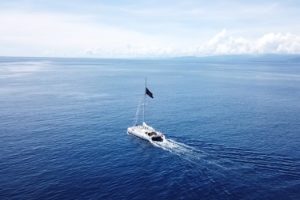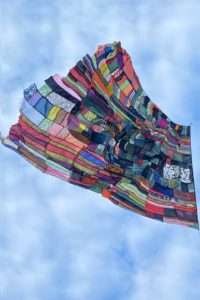The Preventive Peace Flag: this is the title of a special 280 x 500 cm Third Paradise flag that travelled hoisted on the mast of a catamaran from Bali to Raja Ampat, Indonesia as part of Kayu in Viaggio, a group exhibition of works by local and international artists held from 19 April to 2 May aboard the ELSSA catamaran. In addition to recalling a work by Michelangelo Pistoletto, namely the Venus of the Rags (the work is composed of discarded fabrics from a local textile company), the design for the flag stems from the current research of artist and Rebirth ambassador Marco Cassani on water, a theme already developed with his fountain sculpture Ti Amo. “I would like this flag, made from recycled textiles, to become a symbol to raise awareness of the problem of pollution and call on the Indonesian government to regulate waste disposal, which is unfortunately still unregulated,” he said. The title of the exhibition project refers to the 1977 performance L’Attico in viaggio (The Travelling Attico, L’Attico being the name of the gallery), in which the Italian art dealer Fabio Sargentini transformed his gallery into a boat, inviting artists to board the boat and sail along the Tiber. In this case, Kayu in Viaggio sets out to examine the concept of the artwork as a self-sufficient entity capable of generating and acquiring new values within ‘a permanent autonomous zone where objects are simply themselves’; an investigation that began in 2016 with Kayu’s fifth project, Retreat, a group exhibition held in Bali and Java that pursued the idea that lifeless, or seemingly lifeless, things can actually have an existence of their own. The project continued in 2020 with Kayu’s eleventh project, We Move Amongst Ghosts, a group exhibition in Jakarta that examined the potential of objects to recall memories. In its wake, the exhibition investigated the peripheral or central condition of the artwork, reflecting on space and time: Kayu in Viaggio travelled in fact without a real destination. The exhibition was only visible through a photographic and video documentation that was posted daily on Kayu Lucie Fontaine’s Instagram page. Let us now discover all the details of the exhibition project through the words of Marco Cassani.

Let’s start from the collective exhibition Kayu In Viaggio, which places creativity in connection with an unusual context, the marine one. What are the implications of taking art traveling aboard a catamaran? In your opinion, does the exhibition space have a key importance in the fruition of the work or can the latter arise regardless of the context in which it is presented?
For years I have been reflecting on the concept of the artwork as a self-independent work capable of producing new meanings and values in different contexts. Starting with the group exhibition “Ritiro” that I organized in 2016 in Bali and in Java, and continuing with “We Move Amongst Ghosts” in 2020 in Jakarta, the exhibitions reflect on the artworks in their identity and place them far from the classical white cube’s context. Bringing an exhibition and artworks into an unusual environment raises new questions and reflections for me: Is the meaning of the artwork influenced by the context? Does it eliminate, create or highlight its meaning? Does it affect how we receive it? Does the artwork release energy? Who is the audience? Are the artworks read differently?
In particular, “Kayu in Viaggio” reflects on space and time: inspired by the action of Fabio Sargentini from the 1977 exhibition “L’Attico in Viaggio”, the idea is to liberate the artwork from a certain tension, oppression and density that we are experiencing in this historical moment and give the audience a physical and mental distance to see it, as the exhibition is only visible through the video and photographic documentation published on Instagram @kayuluciefontaine . Giving the work the chance to have an echo to inspire something broad and leave the artwork at the mercy of the wind and the sea. In this exhibition, there is certainly a desire for a non-land, to reduce the physical presence of the public to a minimum and to reach a context in which things happen, in which nature reigns supreme. It’s a question of distance and of silence: it is about “shrinking” the artworks and the exhibition and immersing them in an enormous context of blue sky-sea range and waiting for their reminiscence. It is interesting to see that the autonomous and independent organism of the artwork begins to move according to these dictates of time and limits. On board the boat you have less control than when you are on land: there is no definition of control; everything moves immediately governed by the sea and the wind: actions become consequences of things that happen. Seeing and dealing with artworks in these conditions gives you less control over the interpretation and reading than when you see them in a static context on land; for example due to bad weather, the start of the exhibition was postponed for two days, had to close at four, and not every day we were able to hoist the artworks (flags). So yes, I do believe that the exhibition space has a key importance in the fruition of the work.

The international and Indonesian artists involved were invited to design a flag-work produced in Bali, which was hoisted on the catamaran during the twelve days of navigation, from Bali to Raja Ampat. As a creative person, what is your opinion on the artistic potential of an expressive language that takes shape through a flag?
Water is a central theme in my artistic practice: Bali, where I have been based since 2009, has a strong connection with the water element: not only because it is an island, but also for the strong relation that Balinese culture has with it. When I received the invitation to set sail on the catamaran, I immediately sensed the perfect space to insert my work and the ones of my fellow artists: a space between light, water and sky. Personally, I was interested in visually re-associating the wish coins, one of the main materials I am using in my works, to the element of water using the wind and the reflection of light. From here, I had the idea of the work in a flag form, a flag that had to do with hope. My flag of reference was the white one, that of surrender, associated with the weakest party. I see it as a form of nakedness, of the essence of a human being, beyond that there is nothing left: an image of the essence of the individual in relation to everything. Titled “One of the Blessed”, my flag artwork is made up of approximately 300 flattened wish coin cores, sewn onto black satin fabric. Those middle parts are leftovers from my previous “Fountains” series, ongoing since 2015, in which I stack the wish coins I collect on top of each other to form individual columns. When creating the series, I drilled the coins into rings to accommodate the column’s stainless-steel core and repurposed the “leftover” pieces into “One of the Blessed”. I also made a video which accompanied the artwork flag with its same title, in which I echo the act of wishing by throwing the flattened parts of the coin onto a large black satin flag, leaving the constellation that appears on the surface to chance. These were the premises when we invited the selected artists to think about designing their own flag. The flag becomes an expression of the artist’s presence, testimony to a “hic et nunc” existence. In the maritime world, the flag is a language for communicating with other vessels and for showing the origin of the vessel. Hoisting the artists’ flags one by one was also like giving a different profile to the boat, the exhibition space.
You created The Preventive Peace Flag, a work that puts the theme of sustainable fashion under the spotlight with a nod to Michelangelo Pistoletto’s Venus of the Rags. There is also the symbol of the Third Paradise, which you composed by sewing waste fabrics accumulated by a textile company in Bali. What lies behind this work on a conceptual level? Does the flag also have a denunciation or proposal function?
The idea is to have an artwork by Michelangelo Pistoletto that is a synthesis of the collaboration between Cittadellarte – Fondazione Pistoletto and Kayu Lucie Fontaine, which began with the first “Rebirth Forum – Sustainability Through Differences”, held in 2018 in Bali; an artwork that arises from the premises of Pistoletto’s work, with particular reference to the Venus of the Rags, as you rightly say, but is conceived taking into consideration local problems, spacifically that of water pollution in Bali and Indonesia in general. The exhibition has a strong relationship with the marine element and for us it was perfect to have Pistoletto’s work “on board” of the catamaran. The idea of Pistoletto’s flag was born when I exhibited my wishing fountain artwork “Ti Amo” in Jakarta in 2022. The water I used for my wishing fountain sculpture came from the source of the river Citarum, south of Bandung, on Mount Wayang, one of the most polluted rivers in the world and the main source of water for the city of Jakarta. The main reason for the pollution of the river is the dumping of toxic waste from the textile factories located along the river bed, a problem which exist not only in Java but also in Bali. Hence the idea of using the textile waste of a fashion company specialised in batik but also in Bali, to form an approximately 5 x 3-meter flag with the symbol of the Third Paradise. The flag wants to inspire and meditate on water prevention. While sailing, even in the most remote places, we found plastic in the sea. It would be great if the artwork could raise greater awareness of the problem and call for better regulation of discharges into water and the sustainable use of non-recyclable materials.

Let’s focus on the chromatic dimension. The work presents many colours, while the trinamic symbol remains blue, albeit in different shades. What is this choice due to? Is it a way to highlight the link between art and the element of water?
When I proposed the flag idea to the textile company, they welcomed it and gave me bags of rags left over from their production. The rags were mostly silk colored with the traditional Indonesian batik technique. The choice of colours was based on the material we had: we started to divide the rags by colour: there were pure blue rags which immediately struck me for their intensity and the immediate connection with water and with the idea of depth, liquidity and continuous flow, characteristics that can be associated with the symbol of Pistoletto’s Third Paradise, we therefore decided to use them for composing the symbol.
You confirm yourself as a figure of profound connection between Bali and Biella: from the Rebirth Forum in Indonesia to Arte al Centro 2022 in Cittadellarte – which saw you as one of the protagonists with your sculpture Ti Amo (fountain) – up The Preventive Peace Flag. What impact has the empowering role of Rebirth/Third Paradise ambassador had on your artistic practice so far
The role of ambassador has created an interesting bridge between Bali and Biella, in fact between East and West; at the same time this allowed me to reconnect with my origins,i.e. Italian culture. The role of ambassador helps highlight the social part of my artistic practice, which is moving further and further away from the physical human presence and closer to its reminiscence and the traces left by it.

